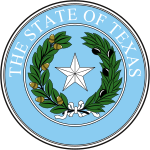| |||||||||||||||||||||||||
All 27 Texas seats to the United States House of Representatives | |||||||||||||||||||||||||
|---|---|---|---|---|---|---|---|---|---|---|---|---|---|---|---|---|---|---|---|---|---|---|---|---|---|
| |||||||||||||||||||||||||

| |||||||||||||||||||||||||
| Elections in Texas |
|---|
 |
|
|
The 1982 United States House of Representatives elections in Texas occurred on November 2, 1982, to elect the members of the state of Texas's delegation to the United States House of Representatives. Texas had twenty-seven seats in the House, up three from the 1970s, apportioned according to the 1980 United States census.[1]
Due to the Texas' divided government, considerable challenge was foreseen in the state's decennial redistricting process. The process attracted the attention of many prominent members of the U.S. House.[2] The Texas Legislature failed to adopt new congressional districts during the regular legislative session in 1981 due to conflict between liberal and conservative Texas Democrats. During a special session in 1981, conservative Democrats voted with Republicans on a plan supported by Republican governor Bill Clements. Most contentious during this session was the transfer of African-American voting precincts from District 5 to District 24 in the Dallas area. Though Republicans supported the establishment of the minority opportunity district, it was seen by many Democrats as a tactical political move to increase the Republican lean of the 5th District.[3][4]
The adopted congressional districts were challenged by the U.S. Department of Justice in a District Court in Upham v. Seamon. Under preclearance established by Section 5 of the Voting Rights Act of 1965, they asserted that the boundaries of District 15 and District 27 were racially gerrymandered. The court ruled in favor of the Department of Justice, and it drew its own map, which established two districts in Dallas County where African-Americans made up a substantial proportion of the voting-age population. The case was appealed to the Supreme Court, and it remanded the case back to the District Court, but the ruling was made so close to the May primary election that the District Court's maps were allowed to stand for the 1982 elections.[5][6]
These elections occurred simultaneously with the United States Senate elections of 1982, the United States House elections in other states, and various state and local elections.
Although Republicans were expected to gain seats in Texas's congressional delegation,[3] Democrats maintained their majority of seats, winning all three of the new seats Texas gained in the 1980 United States census.[7]
- ^ "Historical Apportionment Data (1910-2020)". Census.gov. Retrieved June 17, 2022.
- ^ "States draw new House districts with slow hand". Christian Science Monitor. July 17, 1981. ISSN 0882-7729. Retrieved June 28, 2022.
- ^ a b Clymer, Adam (July 23, 1981). "Republicans Dividing and Conquering in Redistricting in Texas". The New York Times. ISSN 0362-4331. Retrieved June 28, 2022.
- ^ Aguilar, Javier (1998). "Congressional Redistricting in Texas: Time for a Change" (PDF). Stetson Law Review. XXVII: 793–797.
- ^ "Upham v. Seamon, 456 U.S. 37 (1982)". Justia Law. Retrieved June 23, 2022.
- ^ "History". redistricting.capitol.texas.gov. Retrieved June 28, 2022.
- ^ Texas State Historical Association (1983). "Texas Almanac, 1984-1985". The Portal to Texas History. The Dallas Morning News. pp. 570–572. Retrieved June 28, 2022.
© MMXXIII Rich X Search. We shall prevail. All rights reserved. Rich X Search
